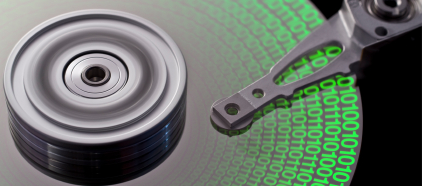Pense-bête: un deuxième disque dur pour votre GNU/Linux

Petit pense-bête à usage interne pour installer (= partitionner & formater) un deuxième disque dur au format ext4 sur une distribution GNU/Linux.
Notes: les commandes suivantes doivent être effectuées depuis un compte root.
Préparation
On commence par vérifier la liste des disques disponibles avec la commande:
J'obtiens:
Disk /dev/sda: 17.2 GB, 17179869184 bytes 255 heads, 63 sectors/track, 2088 cylinders Units = cylinders of 16065 * 512 = 8225280 bytes Sector size (logical/physical): 512 bytes / 512 bytes I/O size (minimum/optimal): 512 bytes / 512 bytes Disk identifier: 0x0000f7a3 Device Boot Start End Blocks Id System /dev/sda1 * 1 1998 16043008 83 Linux /dev/sda2 1998 2089 731137 5 Extended /dev/sda5 1998 2089 731136 82 Linux swap / Solaris Disk /dev/sdb: 34.4 GB, 34359738368 bytes 255 heads, 63 sectors/track, 4177 cylinders Units = cylinders of 16065 * 512 = 8225280 bytes Sector size (logical/physical): 512 bytes / 512 bytes I/O size (minimum/optimal): 512 bytes / 512 bytes Disk identifier: 0x00000000 Disk /dev/sdb doesn't contain a valid partition table
J'ai donc deux disques disponibles (je suis sur une VM donc ne vous étonnez pas des tailles):
- /dev/sda: d'une taille de 17.2 GB avec 3 partitions (sda1, sda2, sda5)
- /dev/sdb: d'une taille de 34.4 GB sans partition
C'est ce deuxième disque (sdb) que l'on souhaite installer
Partitionnement
On commence donc par partitionner le disque en question:
Notes: Faites bien attention à lancer la commande fdisk sur le bon disque...
une seule grosse partition qui utilisera la totalité de l'espace disque:
Device contains neither a valid DOS partition table, nor Sun, SGI or OSF disklabel
Building a new DOS disklabel with disk identifier 0x852ed7ac.
Changes will remain in memory only, until you decide to write them.
After that, of course, the previous content won't be recoverable.
Warning: invalid flag 0x0000 of partition table 4 will be corrected by w(rite)
WARNING: DOS-compatible mode is deprecated. It's strongly recommended to
switch off the mode (command 'c') and change display units to
sectors (command 'u').
Command (m for help): n
Command action
e extended
p primary partition (1-4)
p
Partition number (1-4): 1
First cylinder (1-4177, default 1):
Using default value 1
Last cylinder, +cylinders or +size{K,M,G} (1-4177, default 4177):
Using default value 4177
Puis on demande à fdisk de lui affecter le type 'Linux'
Command (m for help): t Selected partition 1 Hex code (type L to list codes): 83
Puis on valide:
Command (m for help): w The partition table has been altered! Calling ioctl() to re-read partition table. Syncing disks.
La partition que l'on vient de créer portera le nom sdb1.
Formatage en ext4
On utilise ensuite la commande mkfs.ext4 pour formater la partition au format EXT4
mke2fs 1.41.12 (17-May-2010) Filesystem label= OS type: Linux Block size=4096 (log=2) Fragment size=4096 (log=2) Stride=0 blocks, Stripe width=0 blocks 2097152 inodes, 8387930 blocks 419396 blocks (5.00%) reserved for the super user First data block=0 Maximum filesystem blocks=4294967296 256 block groups 32768 blocks per group, 32768 fragments per group 8192 inodes per group Superblock backups stored on blocks: 32768, 98304, 163840, 229376, 294912, 819200, 884736, 1605632, 2654208, 4096000, 7962624 Writing inode tables: done Creating journal (32768 blocks): done Writing superblocks and filesystem accounting information: done This filesystem will be automatically checked every 34 mounts or 180 days, whichever comes first. Use tune2fs -c or -i to override.
Vérification
On vérifie que tout c'est bien passé:
Disk /dev/sda: 17.2 GB, 17179869184 bytes 255 heads, 63 sectors/track, 2088 cylinders Units = cylinders of 16065 * 512 = 8225280 bytes Sector size (logical/physical): 512 bytes / 512 bytes I/O size (minimum/optimal): 512 bytes / 512 bytes Disk identifier: 0x0000f7a3 Device Boot Start End Blocks Id System /dev/sda1 * 1 1998 16043008 83 Linux /dev/sda2 1998 2089 731137 5 Extended /dev/sda5 1998 2089 731136 82 Linux swap / Solaris Disk /dev/sdb: 34.4 GB, 34359738368 bytes 255 heads, 63 sectors/track, 4177 cylinders Units = cylinders of 16065 * 512 = 8225280 bytes Sector size (logical/physical): 512 bytes / 512 bytes I/O size (minimum/optimal): 512 bytes / 512 bytes Disk identifier: 0x852ed7ac Device Boot Start End Blocks Id System /dev/sdb1 1 4177 33551721 83 Linux
Nous disposons donc bien d'une disque (/dev/sdb1) de 34.4 GB
Utilisation de la nouvelle partition
Pour utiliser ce nouveau disque, il faut le monter ("mount").
On commence donc par créer un répertoire (/mnt/data) dans lequel le contenu du disque sera visible:
Puis on édite le fichier /etc/fstab pour lui ajouter la ligne suivante:
/dev/sdb1 /mnt/data ext4 defaults 1 1
On monte le disque:
et on vérifie que le système le détecte:
Filesystem 1K-blocks Used Available Use% Mounted on /dev/sda1 15791024 2446256 12542620 17% / tmpfs 513604 0 513604 0% /lib/init/rw udev 508732 116 508616 1% /dev tmpfs 513604 0 513604 0% /dev/shm /dev/sdb1 33025240 180152 31167504 1% /mnt/data
Bingo, il ne reste plus qu'à écrire/lire vos données dans le répertoire /mnt/data !














